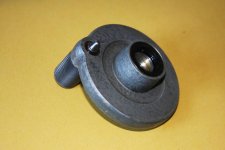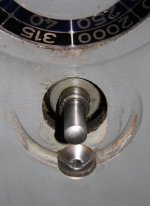Jersey John
Stainless
- Joined
- May 29, 2015
- Location
- Beccles / Suffolk, United Kingdom
Hi folk ...
Some may know that I've recently acquired a 1965 Deckel FP2. As with all machines of this vintage there are always bits to do. In my case a number of bits!
The Speed & Feed handles have springs inside the barrel of the handle that push a locking plunger down into a recess of the operator side of the machine. My springs were virtually totally ineffective and finding the right way to disassemble the handle and replace the springs was not obvious ... but now sorted
Here's the pictures: First the handle, note the rubber oil seal ... second picture the handle in bits lastly what's behind the handle.




To actually get the handle barrel apart you need to drive the plunger pin out of the barrel from the top of the handle with a drift or press (a lot of pressure is required!)
Hope thses notes help someone ...
... and thanks to those that have helped me too! (Ross & Bruce)
John
Some may know that I've recently acquired a 1965 Deckel FP2. As with all machines of this vintage there are always bits to do. In my case a number of bits!
The Speed & Feed handles have springs inside the barrel of the handle that push a locking plunger down into a recess of the operator side of the machine. My springs were virtually totally ineffective and finding the right way to disassemble the handle and replace the springs was not obvious ... but now sorted

Here's the pictures: First the handle, note the rubber oil seal ... second picture the handle in bits lastly what's behind the handle.




To actually get the handle barrel apart you need to drive the plunger pin out of the barrel from the top of the handle with a drift or press (a lot of pressure is required!)
Hope thses notes help someone ...
... and thanks to those that have helped me too! (Ross & Bruce)

John





